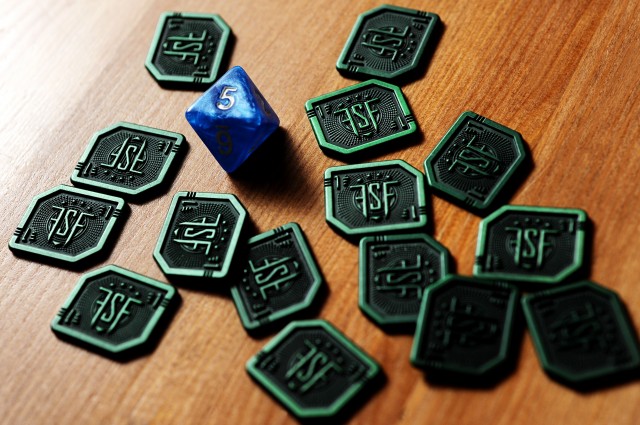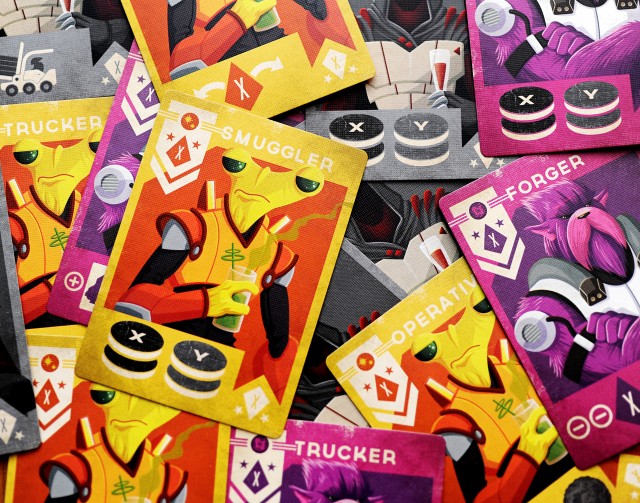In the future, there’s some intense stuff happening out there in space. In this future, the Far Space Federation peacekeeping mission needs their crew on the front lines to gather supplies and resources to make sure the equipment that’s needed can be manufactured in the foundries. You are part of that crew! Get in your freighter and head to remote asteroids, drop off your raw materials to the foundries, and once it’s processed you grab the equipment to fly it out to the Federation.
Far Space Foundry (designed by Dan Manfredini) plays in an intriguing and strategic way, with a little luck thrown in with the cards and how other players take their turns. Players proceed through the game in two halves: Space Foundry Alpha and Space Foundry Beta. The first half of the game is really about maximizing the mining of skyrite (blue crystals) and rubion (red ore), and processing those two to make galactium (purple metal). These will be the raw materials essential to how well you do in the second half of the game.
This part of the game sounds pretty straightforward, but you really have to make sure you optimize your movements between the asteroids and the foundry to ensure you’re not left  floundering. Taking your turn isn’t as simple as moving some pieces about and collecting your raw materials – you’ll play a card from your hand that will allow you to either take off from a docking bay (heading to one asteroid to gather materials) or land at one (bringing your raw materials to your warehouse for storage or processing). Each player has 3 cards out of their deck to select from, and each number corresponds to one of the docking bays in the foundry – playing the right card will let you do a docking or departing action really well, making your turn worthwhile. Sometimes you have to take a hit, if you’re not able to depart or dock optimally – but each docking bay has a special ability you can activate to make lesser choices a little more sweet.
floundering. Taking your turn isn’t as simple as moving some pieces about and collecting your raw materials – you’ll play a card from your hand that will allow you to either take off from a docking bay (heading to one asteroid to gather materials) or land at one (bringing your raw materials to your warehouse for storage or processing). Each player has 3 cards out of their deck to select from, and each number corresponds to one of the docking bays in the foundry – playing the right card will let you do a docking or departing action really well, making your turn worthwhile. Sometimes you have to take a hit, if you’re not able to depart or dock optimally – but each docking bay has a special ability you can activate to make lesser choices a little more sweet.
In the Alpha phase, you can make use of: the Processing Plant (process skyrite and rubion into galactium, which you’ll need for equipment manufacture in the Beta phase), Galactic Traders (trade rubion for cold hard credits) and the Cantina (recruit pilots and their freighters to haul more materials). In the Beta phase, the needs change – the key special ability is the Manufacturing Plant. You will then be able to trade in your raw materials in a variety of combinations to take certain products (robots, drones, ray guns etc.) – you’ll be taking your shuttle arrival/departure actions this round to get those raw materials into the foundry and get the products out to the Far Space Federation, fighting the good fight!
Further to that special ability, there is a Charging Station, whose action allowed you to flip a product token to its charged state, earning you more game-end points; for further game end points, the Freighter Upgrade special ability will let you flip an empty freighter card to make sure you won’t lose points game end. There’s a very delicate balance to getting these actions sandwiched in at the right times to ensure you’re maximizing your ability to gain (or not lose, as the case may be) points at the end of the game. They definitely mesh well with the basic actions you’ll take, but as with any tactical game, your plans can get a bit messed up if you can’t anticipate your opponent’s strategies!
The flow of gameplay and the two phases is very straight-forward and we didn’t have too much issue learning from the rule book. The one thing I did struggle with was the way I could make the best use out of how to play my cards – the number on each corresponds to one of the  docking bays, and if you play well, it means you’re optimizing the action of coming or going. For example, in the Alpha phase, if you’re coming to the foundry, you will be looking to play a card to place a shuttle in an empty space. If you play an 8 and the docking bay is occupied, you shuffle to the next along – and the number of docking bays you try determines the transport capacity of the shuttle. In this instance, I’d have had the capacity for 2 pieces of raw material from whichever asteroid I’m coming in from. I kept on getting confused between that, and the opposite way of departing from the docking bays – in that instance, you want to pick up as much from your foundry warehouse as possible, so you want to play a card that will let you skip a number of empty docking bays until you get to a shuttle. If you play a 4, and have to skip to a 6, you’ll be able to take 3 pieces of raw materials to a freighter of your choice). It’s a pretty cool way of having card play influence ‘worker’ placement/displacement and once the game shifted to the Beta phase I’d gotten the hang of it. I think giving yourself a learning game to understand this strategy would help, and give you a better picture of how you can approach gameplay to make best use of your actions and the special abilities available to you.
docking bays, and if you play well, it means you’re optimizing the action of coming or going. For example, in the Alpha phase, if you’re coming to the foundry, you will be looking to play a card to place a shuttle in an empty space. If you play an 8 and the docking bay is occupied, you shuffle to the next along – and the number of docking bays you try determines the transport capacity of the shuttle. In this instance, I’d have had the capacity for 2 pieces of raw material from whichever asteroid I’m coming in from. I kept on getting confused between that, and the opposite way of departing from the docking bays – in that instance, you want to pick up as much from your foundry warehouse as possible, so you want to play a card that will let you skip a number of empty docking bays until you get to a shuttle. If you play a 4, and have to skip to a 6, you’ll be able to take 3 pieces of raw materials to a freighter of your choice). It’s a pretty cool way of having card play influence ‘worker’ placement/displacement and once the game shifted to the Beta phase I’d gotten the hang of it. I think giving yourself a learning game to understand this strategy would help, and give you a better picture of how you can approach gameplay to make best use of your actions and the special abilities available to you.
If you’re looking for a tactical game with theme well-integrated into how gameplay works, I think Far Space Foundry would hit the spot! Part set collection, hand management and worker placement, there’s a lot going on – the variety of alien pilots and their special abilities, plus the items for manufacture, means you could try each game a little differently to see what strategies work best. And last but not least – the art in this is so awesomely futuristic and really well-designed. Kudos on the choice of Adam McIver, he did a great job! So if you thrive on logistics, combos and optimization in games then you’ll be right at home in the support crew of the Far Space Federation.
Far Space Foundry is published by Terra Nova Games. It plays 1 – 4 people ages 13+ and takes approximately 20 minutes per player.
Comments
No comments yet! Be the first!